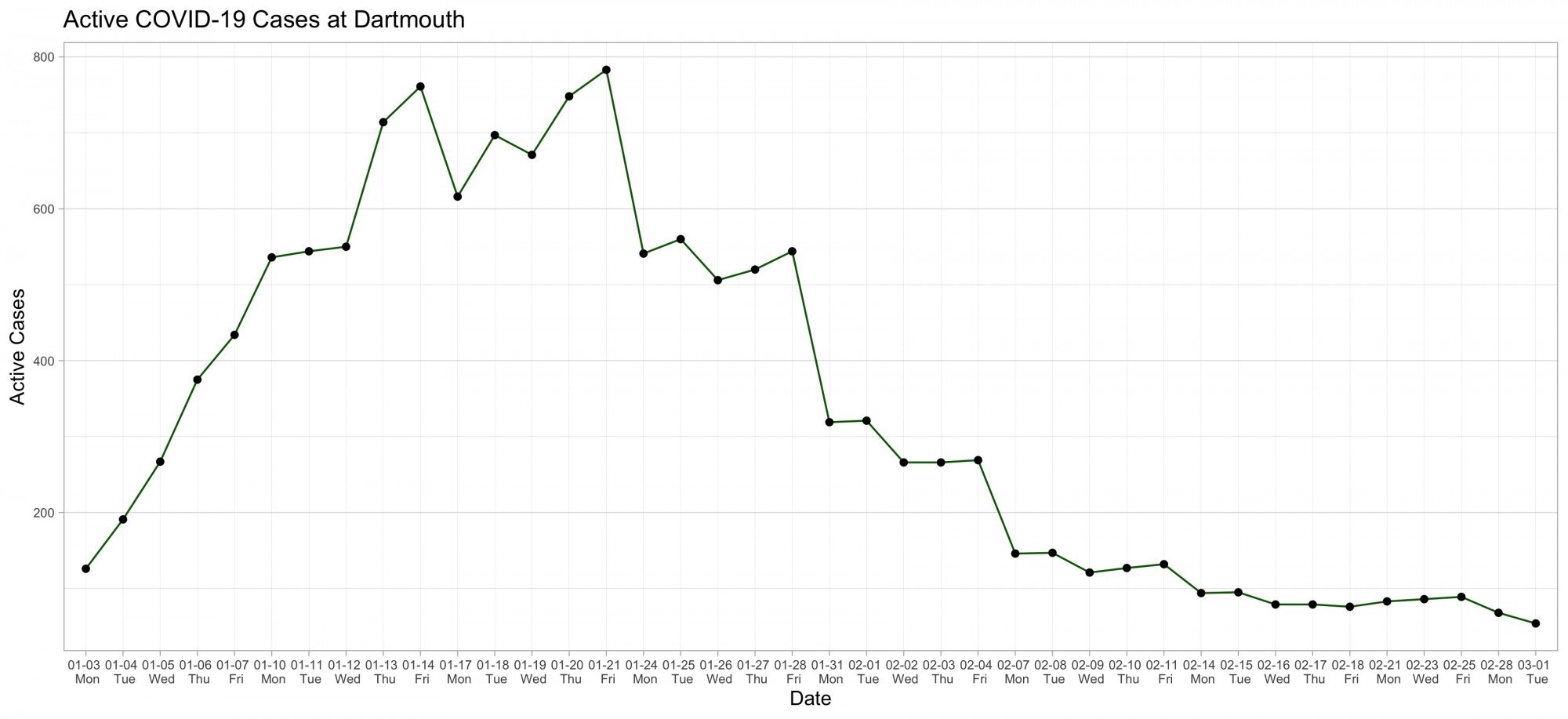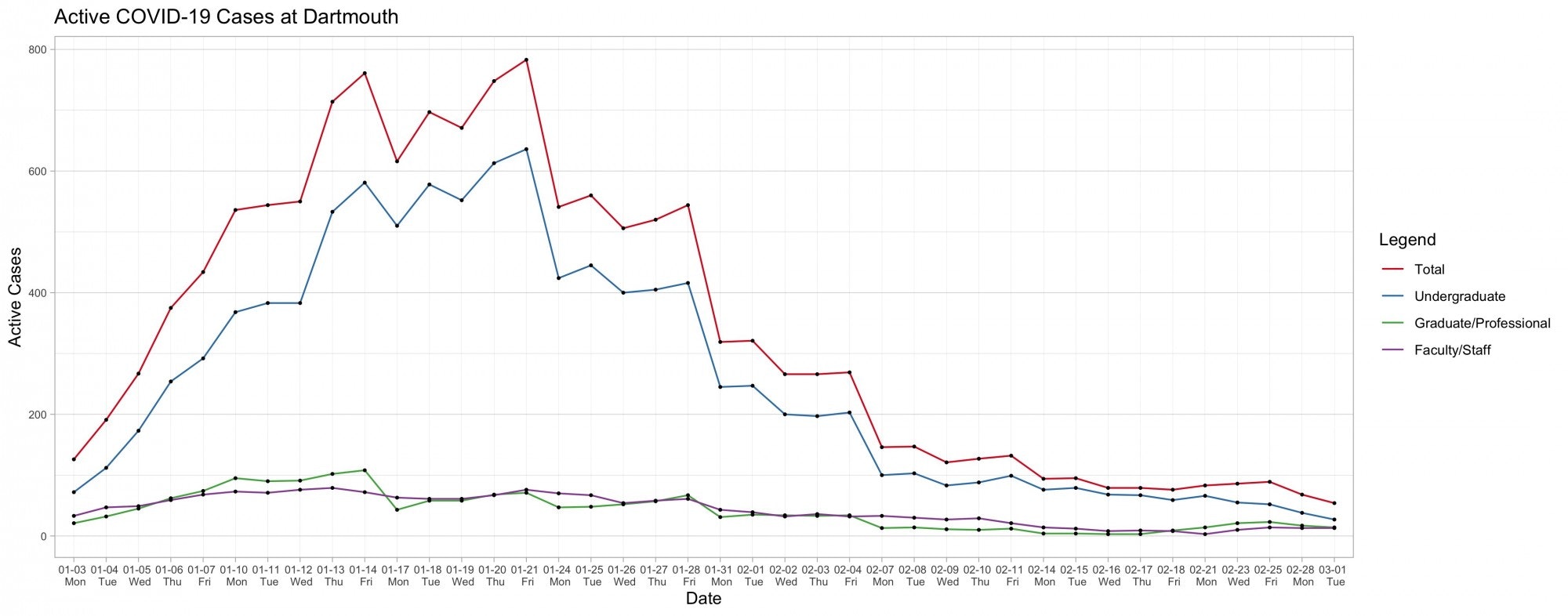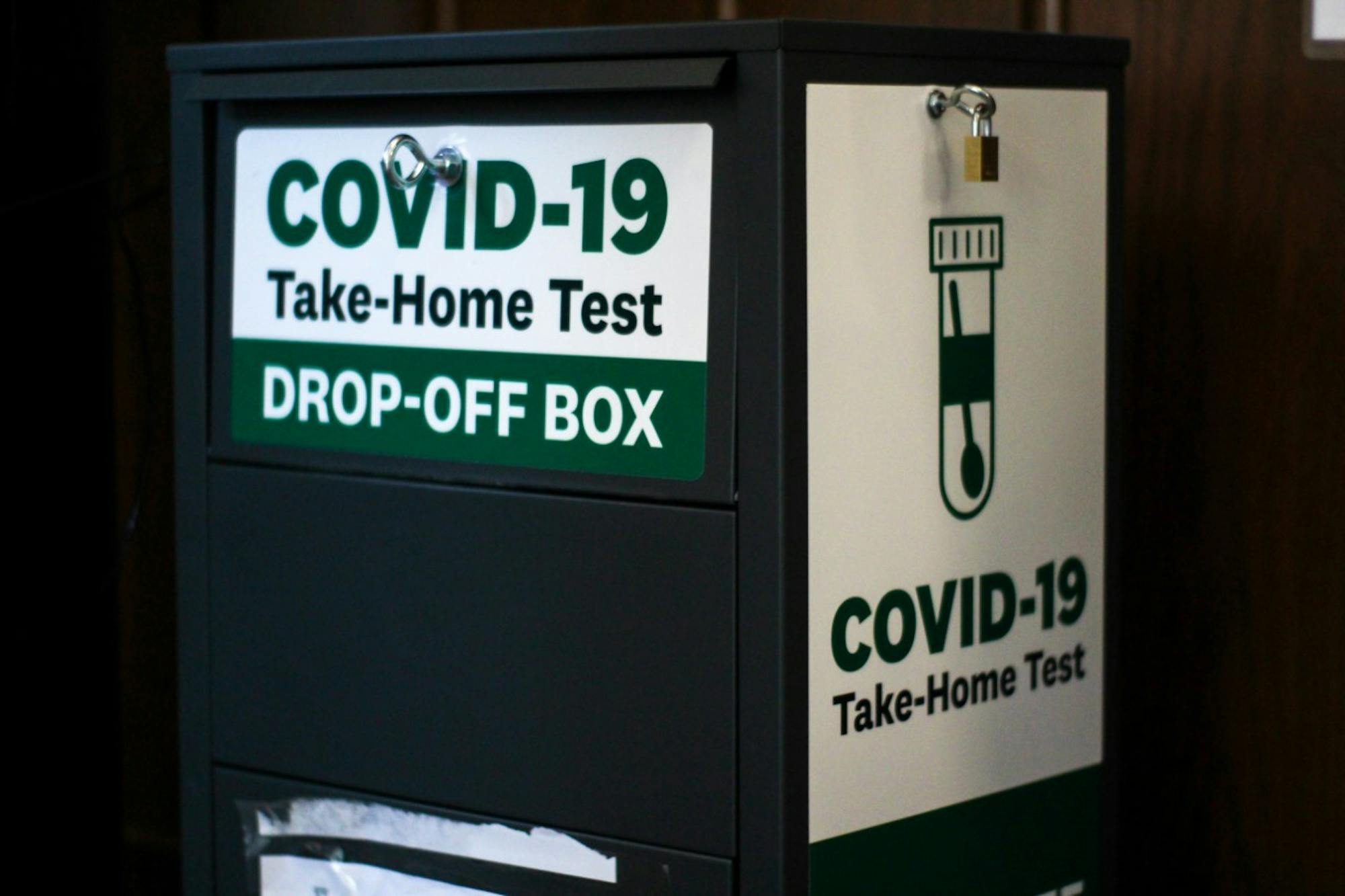Updated 11 a.m., March 4, 2022.
Between Jan. 1 and Feb. 28, 1,812 students of the 6,339 enrolled in classes this term contracted COVID-19, representing roughly 29% of the undergraduate and graduate student body, College spokesperson Diana Lawrence wrote in an emailed statement. This total represents a 6-point increase from the roughly 23% of the student body who had tested positive between Jan. 1 and Jan. 25.
While this winter saw record high case numbers, total active cases have been trending steadily downwards in recent weeks.

The graph reflects the total number of active COVID-19 cases at Dartmouth since the start of the term.
The same is true nationwide — the United States is down to an average of roughly 54,000 new cases per day, the lowest since July 25, 2021, according to data from The New York Times. Deaths and hospitalizations, however, remain significantly elevated.
On Feb. 25, the Centers for Disease Control and Prevention released new COVID-19 risk assessment guidelines with reduced safety precaution recommendations for many parts of the country. According to data from the CDC, which was most recently updated on Thursday, Grafton County is currently classified as a medium risk zone, meaning that the CDC no longer recommends indoor masking unless a person is high-risk.
According to a March 2 press release from the College, the College’s COVID-19 leadership team is currently reviewing the revised CDC guidance and intends to announce updates to masking and surveillance testing policies for spring term as soon as next week.
The picture was different at the beginning of the term when, despite new and continued College COVID-19 protocols, the omicron variant spread rapidly on campus, as it did in the rest of the country.
“Omicron spreads so quickly that even with our surveillance testing, and even with isolation, we were not going to be able to prevent it from spreading on campus,” provost David Kotz ’86 said in a Q&A with The Dartmouth in February. He noted in the Q&A that as the winter term began, the College decided to focus on how to manage the pandemic, rather than how they could stop it.
On Dec. 18, then-interim provost Kotz and executive vice president Rick Mills announced additional COVID-19 prevention measures for the winter term, including grab-and-go dining, restrictions on indoor gatherings and a booster shot mandate. On Dec. 29, Kotz and Mills sent another email to campus committing to in-person classes, in contrast with peer institutions like Harvard University and Yale University, which delayed move-in dates and began classes remotely.
According to The Dartmouth’s coverage of the pandemic, which sources data from the College’s COVID-19 dashboard, case numbers rose quickly after the term started, resulting in the highest COVID-19 positivity rate among peer schools by early February.
The number of active cases peaked on Jan. 21, when there were 783 active cases among students, faculty and staff. The vast majority of cases all term were among undergraduate students.

The graph reflects a breakdown of active COVID-19 cases at Dartmouth since the beginning of term among undergraduate students, graduate and professional students and faculty and staff.
Case numbers have since fallen drastically; as of March 3, there are 53 total active COVID-19 cases. According to the College’s COVID-19 dashboard, a case is considered active while the individual is in isolation or is still receiving medical care for symptoms.
In contrast to dedicated isolation housing in previous terms, students who tested positive isolated in their rooms this winter. Sarner Underground was converted to a meal pick-up facility for students with active COVID-19 cases. While the College committed to in-person classes, some students who tested positive reported falling behind academically as some courses did not offer remote learning or offered options that they found lacking.
Many campus facilities adjusted their operations in response to the new College restrictions. FFB was closed throughout the term, and the opening of Cafe@Baker was postponed. Both facilities are set to open when the College lifts its indoor mask mandate.
In response to the ban on student gatherings, the Inter-Sorority Council conducted sorority rush virtually this term. Greek houses reported increased policing by Safety and Security, resulting in some houses being suspended, put on probation or receiving warnings from the College.
Labor shortages due to the pandemic also significantly affected campus operations. Floren Varsity House was closed for the first ten days of winter term, resulting in overcrowding in Zimmerman Fitness Center, while the Sexual Violence Prevention Project canceled all planned programming for the Class of 2023.
Lost work because of COVID-19 isolation and increased stress due to the campus-wide staffing shortage further exacerbated dissatisfaction among Dartmouth Dining Services student workers, culminating in the announcement of their intent to unionize under the Student Worker Collective at Dartmouth. The College opted not to voluntarily recognize the union, and a student worker election this month will determine if the union will be officially recognized by the College.
Students had mixed reactions to the College’s policies, generally approving of the decision to commit to in-person classes but expressing concern over isolation protocols. With the increasing case numbers, some students resorted to humor to cope with the situation.
Becca Wade ’22 said she started a GroupMe group chat named “Built Different” in the first week of winter term. According to Wade, students who had yet to test positive for COVID-19 were invited to join the GroupMe but would have to leave the group if they tested positive.
“My roommate tested positive, and some of my friends’ roommates tested positive, but [my remaining friends and I] hadn’t, so we said that this was crazy — we must be built different,” Wade said. “In the group, some people posted messages like, ‘Oh my god, how did we make it so far?’ But then one by one, they would say that they spoke too soon and left.”
Wade said she left the group after testing positive in the third week of the term. As of March 3, there are 875 members still in the group chat.
As the term progressed, many of the College’s restrictions were gradually lifted. Indoor dining at campus dining locations resumed on Jan. 10, and student organizations were allowed to resume in-person meetings after the first two weeks of the term on Jan. 16. On Feb. 14, in response to falling case numbers, College-sponsored indoor events were once again allowed to serve food and drink.
Noting the fact that the majority of Dartmouth community members will have received the booster shot by the beginning of spring term, Kotz is quoted in the March 2 press release saying that “it’s time for us to start thinking about relaxing constraints.”
Correction appended (March 4, 2022, 11:00 a.m.): A previous version of this article, as well as its headline, contained incorrect statistics about the numbers of students who have tested positive for COVID-19 this term. The incorrect numbers were provided by the College Health Service to College spokesperson Diana Lawrence, who in turn provided them to The Dartmouth. After this article’s publication, Lawrence was sent correct statistics and then provided them to The Dartmouth.
1,812 students have contracted COVID-19 since Jan. 1, 2022, not 2,505. This represents roughly 29% of the student body enrolled in classes this term, not 39.6% — a six-point increase from Jan. 25, not a 17-point increase. The article and headline have been corrected.




